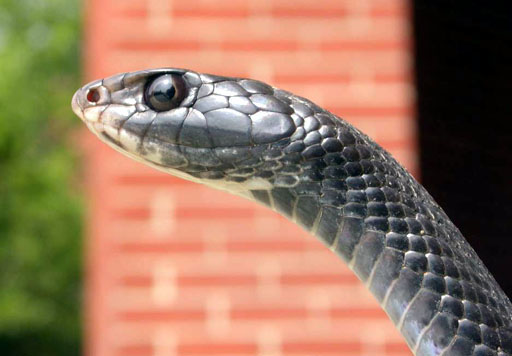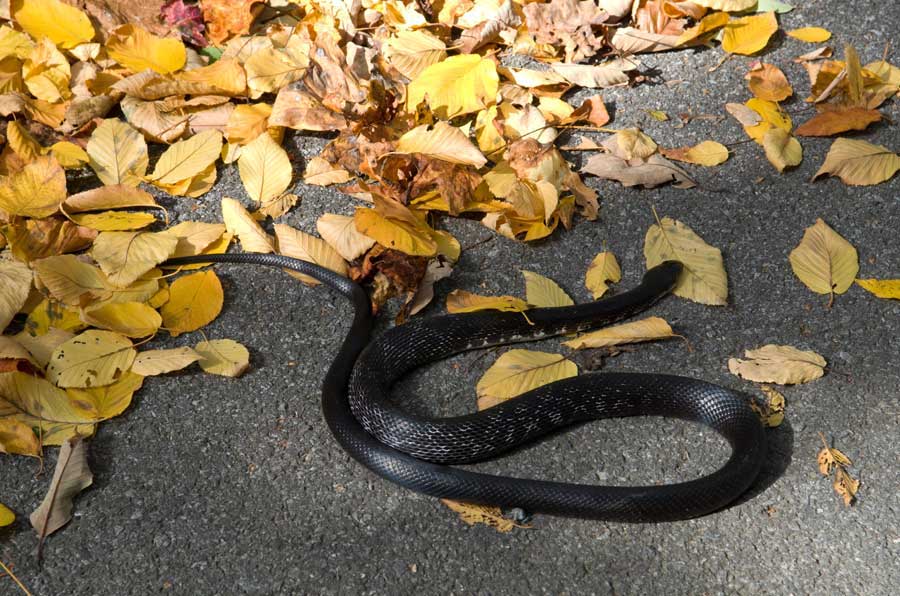You may be familiar with the idiom “opening a can of worms,” but what about “opening a can of black snakes”?

In fact, this is the story about a can of black snakes rearing their heads and hissing!
For reptile lovers, copperheads, rattlesnakes and black snakes can be found at Watoga State Park. However, this post concentrates on just one species: the seemingly harmless black snake — the Northern black racer: (Coluber c. constrictor).
“This snake is slender, glossy black in color and may attain a length of six feet. The dorsal scales are smooth and the chin and throat are white. Black Racers occur throughout the state in moist woodlands and fields, where they feed on birds and mammals, as well as amphibians and reptiles. Approximately 25 off-white, elliptical eggs are deposited in loose soil or sawdust piles. Hatchlings have 30 or more reddish brown blotches on a gray background. The banded juvenile pattern slowly disappears as the snake grows larger, and the snake is completely black by the time it reaches 30 inches in length.”
“Snakes of West Virginia,” published by the West Virginia Division of Natural Resources, Wildlife Resources Section.
Ophidiophobia
So, do snakes scare you too?
Before opening that can of black snakes, let me confess that snakes scare me! All snakes. This phobia is known as Ophidiophobia, or ophiophobia. Furthermore, I don’t care if they are venomous or not. For example, just researching and reading a blog post about snakes at West Virginia‘s largest state park creeps me out. Maybe you have nightmares about these reptilians too. In that regard, a future blog will delve into the vivid details of how I became so terrified of snakes.
Let’s Talk About This Can of Black Snakes
Now that you know one of my greatest fears in life, let’s begin to open (ever so carefully) that can of black snakes.
The year: 1963. The place: Near Beaver Creek Campground. The participants: My brother, Gilbert, my sister, Della, and my mom. Gilbert is 9. Della is almost a teenager. Mom is pregnant with my youngest sister, Vicki Lynn.
However, I am just a toddler in the early 60s, Freckles, our pet deer has yet to be rescued by my dad, and the black bear with Paul McCartney eyes has yet to be seen near Calvin Price State Forest.
To begin with, my brother Gilbert is behind the adventurous and daring display that leads to those snakes becoming the topic of Dean conversations for decades to come. When snowstorms knock out our electricity for days on end at the park, we sometimes tell ghost stories and, of course, this snake story too, as we sit huddled together with kerosene lanterns casting an eerie glow about the living room at Watoga.
I recall mom (1921-1998) telling us about Gilbert’s antics, but I wanted to hear Gilbert’s and Della’s versions of those events once more.
The Black Snakes are Hissing
“C’mon mom, I wanna show you something,” Gilbert says.
Even though mom is tired after a day of working in the fields at my grandparents’ 211-acre farm that borders Watoga, she follows Gib that hot summer day at the park. Della, 12, walks beside mom.
At 9, Gib is excited to reveal his “surprise” to Mom. As with most Deans, adventures at Watoga oftentimes lead to interesting and mischievous adventures and practical jokes.
The trio walk to the trash cans situated between our home and the brown wooden sided maintenance garage near the campground.
“Look, Mom, look what I found!” Gilbert excitedly says. “Look inside the garbage can.”
Opening the shiny metal lid, Mom sees about 20 black snakes of various sizes and shapes encircling the bottom of the 30-gallon trash container trying to slither their way to the top of the can.
“The black snakes are all curled up. They are trying to climb up the side of the garbage can. Their heads rear, their mouths open, and they hiss loudly.”
— Della Dean Johnson
A New Version of Afternoon Sickness
After peering inside the trash receptacle, Mom lets out a scream that can be heard as far away as Kennison Mountain, about 16 miles from the park.
Obviously, Mom is not a fan of snakes either.
“Git rid of those snakes right now, right away,” she sternly tells Gib. Della remembers that Mom got sick after seeing the snakes, and it is not your typical morning sickness either. So, instead, a new version of afternoon sickness is unleashed that day.
A Few Slithery Details

So, just how do those reptiles get in the trash can?
Gib discovers a nest of the black snakes in a couple piles of saw dust between our home and the nearby maintenance garage about 200 yards from the campground.
“I find quite a number of them,” Gib recalls. “These are not baby snakes either. They range in size from about 2 or 3 feet to about 5 feet. Because I didn’t have a stick or anything to catch them with, I grab them with my hands; I put two fingers at the base of the snake’s neck to where it cannot bite me. I didn’t get bit once. They did climb up my arm and squeeze it though.”
I wanted to know if Vicki also had a fear of snakes. She says emphatically: “I hate them!”
Needless to say, I am leery of opening any garbage can lids.
In conclusion, I like a good laugh or two or enjoy pulling a prank too — just none involving black snakes, copperheads or rattlers. To put it another way, and as my mom screamed that day, “Git rid of those snakes right now, right away!”
About the Author
John C. Dean lived at Watoga for 16 years from 1960-1976, until his dad, Vernon C., retired after 43 years of service with the West Virginia Division of Natural Resources. He can be reached at .